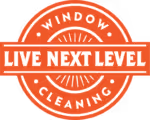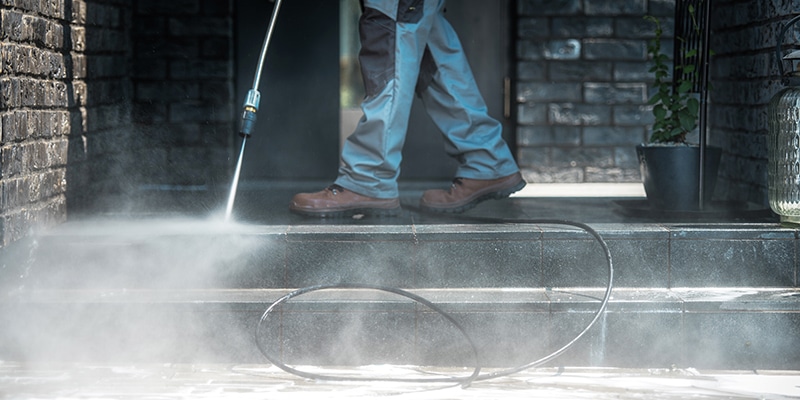Concrete cleaning with pressure washing is a necessary part of any home or business maintenance, providing an efficient and cost-effective way to keep surfaces clean. Pressure washers are powerful tools that can quickly remove dirt, grime, and debris from a variety of hard surfaces. However, it is important to take certain precautions when using a pressure washer on concrete as improper use can cause damage or put the user at risk.
This article will provide an overview of how to safely and effectively use a pressure washer for concrete cleaning, including areas to prepare before starting work, selecting appropriate equipment, testing the pressure washer before each use, cleaning in smaller sections for best results, and taking necessary safety precautions throughout the process.
Prepare the Area
Prior to pressure washing, it is essential to ensure that all objects and surfaces in the area are adequately prepped and protected. This includes using protective gear such as goggles, gloves, and masks to protect oneself from any debris or chemicals being sprayed by the pressure washer.
It is also important to check the weather conditions since wet surfaces can become slippery and increase the risk of an accident occurring. Additionally, if rain is in the forecast, it may be best to reschedule the job for a different day.
Cleaning agents should also be chosen carefully based on what kind of material is being cleaned. For example, using a mild detergent with warm water is usually sufficient for cleaning concrete but tougher stains may require a stronger solution such as bleach or trisodium phosphate (TSP). When applying chemicals onto concrete, one should always test them first on a small inconspicuous area so that any potential discoloration can be avoided.
Once everything has been prepped and ready for pressure washing, it’s time to begin by starting at the top of the surface working down towards the bottom. This will help reduce any splatter from flying onto other areas while also allowing gravity to assist in pushing dirt off of vertical surfaces more quickly.
Any loose debris should also be removed prior to starting in order to prevent clogging up nozzles or damaging pumps on power washers.
Choose the Right Equipment
Selecting the appropriate equipment for a pressure washing job is essential to achieving optimal results. A professional-grade pressure washer, such as a gas-powered model with an output of between 1,500 and 3,000 PSI (pounds per square inch) is recommended for most concrete cleaning jobs. It is important to choose the correct nozzle size depending on the type of surface being washed – 25 degree nozzles are suitable for most residential applications while 40 degree nozzles are better suited for industrial use. Renting equipment may be more cost-effective than buying it outright.
Pressure washers come in different sizes and shapes, and deciding which one is right for your project can be difficult. If you will be using the pressure washer outdoors or indoors, make sure that you pick one designed specifically for that purpose; some models may not be safe to use indoors due to their exhaust fumes or sound levels. Additionally, consider attachments like brushes or detergent tanks if they are needed.
Finally, all safety precautions should be taken into account when selecting a pressure washer: make sure you understand how to operate it safely and never point the nozzle directly at yourself or anyone else! Always wear protective gear such as long pants and closed-toe shoes when operating any power tool. To ensure success with your project, take time to properly research what kind of equipment would best suit your needs before making any purchases or rentals.
Test the Pressure Washer
Before using a pressure washer, it is important to test the machine in order to ensure optimal performance.
This involves testing the power of the pressure washer as well as its settings.
To test the power of the pressure washer, set up a nozzle on a flat surface and observe how far away you can stand while still feeling the force of water coming out of it. The further away you can stand from the nozzle, the more powerful your pressure washer is.
Additionally, be sure to test all available settings on your pressure washer so that you are familiar with them before beginning your cleaning job. For example, some machines offer adjustable nozzles that enable users to change between different spray patterns and intensities depending on their needs.
Once these tests have been completed, it is imperative to make any necessary adjustments or repairs prior to beginning a concrete cleaning job with a pressure washer.
Not only will this ensure that optimal results are achieved but also that safety protocols are met by avoiding any potential accidents or injuries resulting from an improperly functioning machine.
Furthermore, checking for leaks in hoses or fittings should also be done in order to avoid wasting water during use and potentially damaging surfaces around where you’re working due to overspray.
Finally, testing your pressure washer prior to use helps build confidence in achieving desired results for concrete cleaning jobs and demonstrates good practice when handling specialized equipment such as industrial-grade pressure washing machines.
Clean the Concrete in Small Sections
Carefully sectioning the area to be cleaned is important in order to ensure proper and efficient pressure washing of concrete surfaces. Pressure washers that are too powerful can damage both the surface and underlying structures of the concrete, while those that are too weak may not be effective in removing dirt or stains. It is therefore important to maintain a consistent level of pressure when cleaning different sections of the concrete.
Additionally, detergents should also be used for more thorough cleaning, though it is best to avoid using harsh chemicals which may damage the surface of the concrete. The cleaning solution should also be rinsed off completely after use so as not to leave any residue on the surface.
By sectioning off small areas at a time, it becomes easier for operators to focus their attention on each individual area and achieve better results overall. This allows them to apply more precise levels of pressure as well as create an even distribution of detergents across the entire surface being washed. Furthermore, this method ensures that no single spot receives excessive amounts of water or chemicals and thus reduces any risk of damage due to over-washing or over-saturating certain sections.
The process should begin by hosing down the entire surface with a low-pressure spray before moving onto specific spots that require special attention such as heavily stained areas or high traffic zones where dirt tends to accumulate quickly. Having prepped these areas beforehand will enable operators to tackle them with greater ease without running into any unexpected issues during actual cleaning operations.
Take Necessary Safety Precautions
When pressure washing concrete surfaces, it is necessary to take certain safety precautions in order to ensure a safe and successful operation.
Protective gear such as goggles, boots, gloves, and ear protection must be worn at all times. This prevents any hazardous materials from getting into the eyes or coming into contact with the skin.
Additionally, it is important to make sure that the area is well ventilated so that fumes from any chemicals used do not become trapped in enclosed spaces.
When using soap for pressure washing concrete surfaces, it is important to make sure that the soap used contains no harsh abrasives or solvents which can damage the surface of the concrete.
It should also be noted that if any type of chemical cleaner needs to be applied then it should be done carefully and only after testing on an inconspicuous area first.
The water temperature should also be monitored closely because too hot of a temperature can cause discoloration or fading of some types of concrete sealing products.
Finally, one should always use caution when operating a pressure washer as they have enough power to cause damage if not handled properly.
Careful attention should be paid to nearby objects such as windows or vehicles in order to prevent accidental spray damage and injury due to high-pressure streams of water being propelled through air at high speeds.
All these safety measures will help ensure a successful cleaning job with minimal risk involved!
Conclusion
Through the ages, pressure washing has been likened to a modern-day knight slaying grime and restoring beauty.
The task of cleaning concrete is no different; with the right equipment, attention to detail, and safety precautions in place, it can be a simple and rewarding experience.
Taking time to prepare the area, choose the right equipment for the job, test your pressure washer before use, clean small sections at a time and observe all safety precautions are essential components of successful concrete cleaning with pressure washing.
When these steps are followed correctly, an attractive new surface can emerge from beneath layers of dirt and debris.




